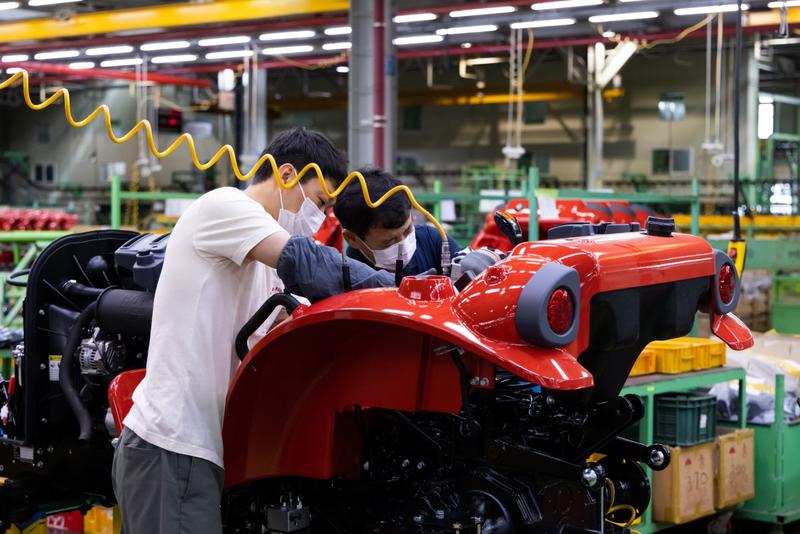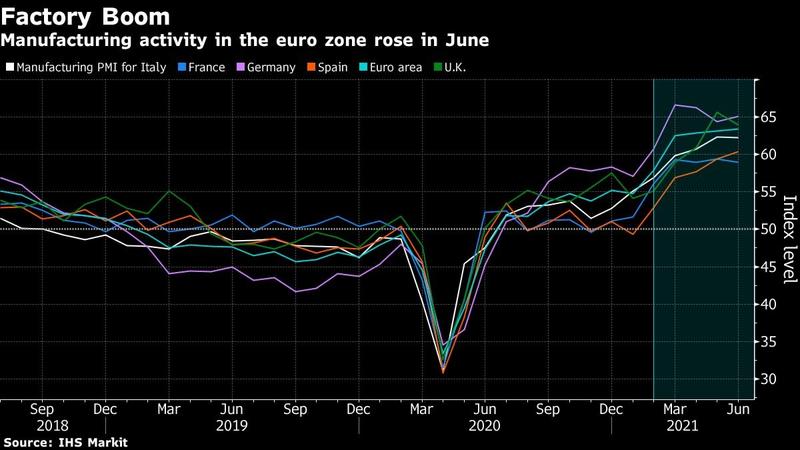 In this undated photo, employees assemble a tractor on the production line at the TYM Corp factory in Iksan, South Korea. (SEONGJOON CHO / BLOOMBERG)
In this undated photo, employees assemble a tractor on the production line at the TYM Corp factory in Iksan, South Korea. (SEONGJOON CHO / BLOOMBERG)
Asia’s manufacturers are seeing the area’s economic recovery stumble as the pandemic weighs on output and vaccinations lag other regions, increasing their reliance on exports to the rest of the world.
Asia’s export engines are scrambling to minimize disruptions to production as the virus flares up in parts of the region, including recent surges in Malaysia, Indonesia and Vietnam
At the same time, Europe’s bofoming economy is battling a supply squeeze that is pushing up prices and running down stockpiles.
Malaysia’s manufacturing purchasing managers’ index declined to 39.9 in June, its lowest in more than a year, from 51.3. Vietnam and India, which have been battling a recent resurgence of the virus, slipped below the 50 level that separates expansion and contraction.
“The recent rise in COVID-19 infections and associated containment measures once again dampened demand, stymied production and disrupted supply chains” in Malaysia, said Chris Williamson, chief business economist at IHS Markit. “Companies grew more concerned about the potential impact of further virus waves.”
ALSO READ: Asian factories continue recovery from virus woes as China booms
South Korea, an export powerhouse that continues to benefit from the boom in the electronics cycle and surging demand for semiconductors, remained well into expansion territory, at 53.9 and 57.6, respectively.
Asia’s export engines are scrambling to minimize disruptions to production as the virus flares up in parts of the region, including recent surges in Malaysia, Indonesia and Vietnam. In contrast, European inoculations have advanced to the point where lockdowns can be eased, launching the continent into an economic boom.
The was reflected in euro-area and UK manufacturing PMIs on Thursday, which were at or near the highest levels since the data started being collected more than two decades ago.
Still, factories reported that they are being held back by supply constraints and were forced to dip into inventories. Producers raised their goods prices by the most in record. Williamson said issues such as port congestion and a lack of shipping containers should soon fade.
The relatively steady expansion in China is also a boon for the rest of Asia, much of which relies on it as its top trading partner. The Caixin Media and IHS Markit manufacturing purchasing managers’ index for China eased to 51.3 from 52, according to a release Thursday morning. The gauge has been in expansion since May 2020.

China’s official manufacturing purchasing managers’ index was little changed at 50.9 in June, marking a 16th straight month of expansion, the National Bureau of Statistics said Wednesday. The non-manufacturing gauge, which measures activity in the construction and services sectors, decreased to 53.5 from 55.2, largely due to virus outbreaks in parts of the country.
Exports from South Korea, a bellwether for global trade, rose more than expected in June, government data Thursday showed, continuing a rally that has officials expecting shipments to reach record highs this year.
“There is a lot of investment currently underway to address the global shortfall of supply relative to the demand for semiconductors,” including around US-China technology conflicts, Rob Carnell, head of Asia-Pacific research at ING Groep in Singapore, said in a report Wednesday. “Extra supply will not come on-stream quickly,” even as electronics demand remains strong.
READ MORE: Steady uptick in production at factories
In Japan, where the au Jibun Bank and IHS Markit PMI eased to 52.4 from 53 in May, businesses have grown more upbeat on the outlook, with sentiment at the strongest level since the series started in July 2012.
That matches the Bank of Japan’s Tankan survey out earlier Thursday, which showed confidence among Japan’s large manufacturers improving for a fourth straight quarter to its highest level since 2018, even as virus restrictions remain in place.


